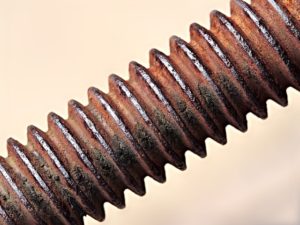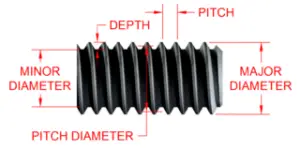In short, the idea behind how micrometers work is a combination of these two: the working principle of the differential screw and the distance magnifying that is affected by the thimble diameter. In this page, we only explain the micrometer working principle of the mechanic type one.
Differential Screw
According to Wikipedia,
“A differential screw is a mechanism used for making small, precise adjustments to the spacing between two objects (such as in focusing a microscope, moving the anvils of a micrometer, or positioning optics)”.

This mechanism, the differential screw, allows the spindle able to go forward and backward in an extremely tiny movement. In the best micrometer, it can reach up to 0.0001mm per adjustment. This mechanism only behaves to the way the spindle acts in forward and backward direction.
Magnifying the Distance
In the way the spindle moves in rotating direction, its distance is very clear to see. So, when the spindle moves 1mm in forward direction, the rotating distance is definitely longer than that. The thimble’s rotation distance is equal to its circumference.
Let’s explain it in the following example.
When a thimble rotates completely, the adjustment distance in forward direction is observed as 1mm. On the other hand, the adjustment distance in rotation direction (the circumference) is observed as 10mm. Having that said we can conclude that the ratio is 1:10.
This is the magnifying process happens.
Every time the spindle moves 1mm in forward direction, the thimble also moves 10mm in rotation direction. Suppose the micrometer has 0.1mm resolution. How could you read the graduations of 0.1mm, 0,2mm, 0.3mm, … and 0.9mm in 1mm space? It’s too narrow. You may not want to read it.
Things happen differently if we employ the thimble to be the place of those (0.1mm, 0,2mm, 0.3mm, … and 0.9mm) graduations. If the thimble’s circumference is 10mm linearly, it should be visible to put 10 lines of graduation there. So, we can print 0.1mm per 1mm.
Having that said, every time the spindle adjust forward in a range of 0.1mm, the thimble is spun 1mm. The 1mm space is magnified into 10 graduations which consist of 0.1mm spacing each graduation. Remember that this is only an example. The real micrometers have more than that 10 graduations.
If you need a clearer explanation, then the video below will help you a lot. The micrometer working principle is explained at the time span of 1:24 to 4:43.
Another Way to Understand How Micrometers Work
Before you read the entire article, we recommend you know all the terms below:

- Pitch. Pitch is the nearest distance between two closest thread peaks. It can be also described as the nearest distance of one complete rotation in forward direction.
- Spindle. The spindle is the movable part of the micrometer that secures to the objects to be measured. It’s actually a long metal that extends until reaching the ratchet.
- Threaded spindle. It is the part of the spindle that is threaded. Almost half of the spindle is threaded like a screw.
To understand how a micrometer works easier, you are better off looking at the internal mechanism directly. If you disassemble the micrometer, you’ll find that the spindle is actually a long threaded cylindrical metal. However, it is hidden because the sleeve and barrel (thimble) cover it.
The video above will help you visualize better disassembling a micrometer. Watch from minute 5:16 to 12:35. From the video, you’ll also see how the spindle actually is.
This threaded spindle is the key part of a micrometer. It’s where the differential screw working principle occurs. If you look at it carefully, the barrel (thimble) connects to the spindle. So, when you rotate the thimble, the spindle will rotate as well and move forward or backward as desired.
Suppose that the pitch length of the micrometer you are disassembling is 1mm and the measurement range is 25mm (≈1inch). It can be concluded that it must have at least 25 threads (25:1=25).
The most interesting part of a micrometer is the 1mm above. It will be divided or magnified again by the number of graduations available on the thimble. If we assume the thimble provides 50 graduations (0 to 49), it means the resolution is 0.02 (1mm:50=0.02). So, the magnifying is 50 times. Furthermore, the micrometer is stated able to detect any thickness or length or movement per 0.02mm.
The most common smallest scale is in millimeter. To put those 50 graduations on the thimble and they are set to be easy to see, then the space between each mark should be 1mm in length. That being said, the total circumference is 50mm in linear measurement.
This magnifying is very helpful in measurement. You certainly don’t want to read the terribly tiny 50 graduations in 1mm space, do you? Once again, the thimble helps significantly magnify the 1mm space into a wider 50mm space.
Conclusion
How the way micrometers work is actually amazing. It’s able to detect any movement within a very tiny distance. Even it’s possible to make it more precise again.
After you read this article, please answer the questions below!
- What is the most important part of the micrometer that makes the micrometer able to move very tiny distance and able to measure up to 0.001mm?
- How could you get that 0.001mm number?
Answers:
- The threaded spindle and the thimble diameter. The threads make the spindle able to go forward and backward in the extreme small movement. Further, the diameter of thimble allows it to magnify that small distance into smaller ones.
- That 0.001mm value above is found from the calculation. The forward distance of one rotation is divided by the number of graduations. It has a big correlation between the precision and the thimble diameter. The wider the diameter, the smaller the number can be.
